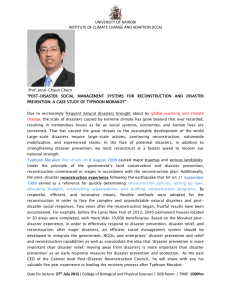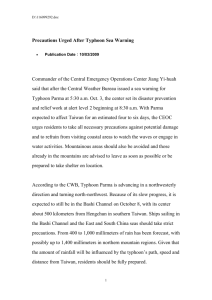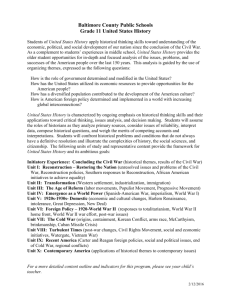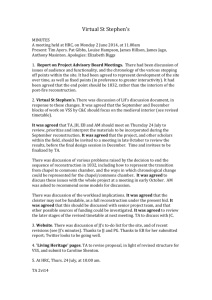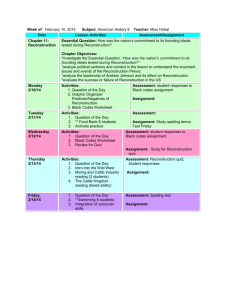3. reconstruction plan
advertisement
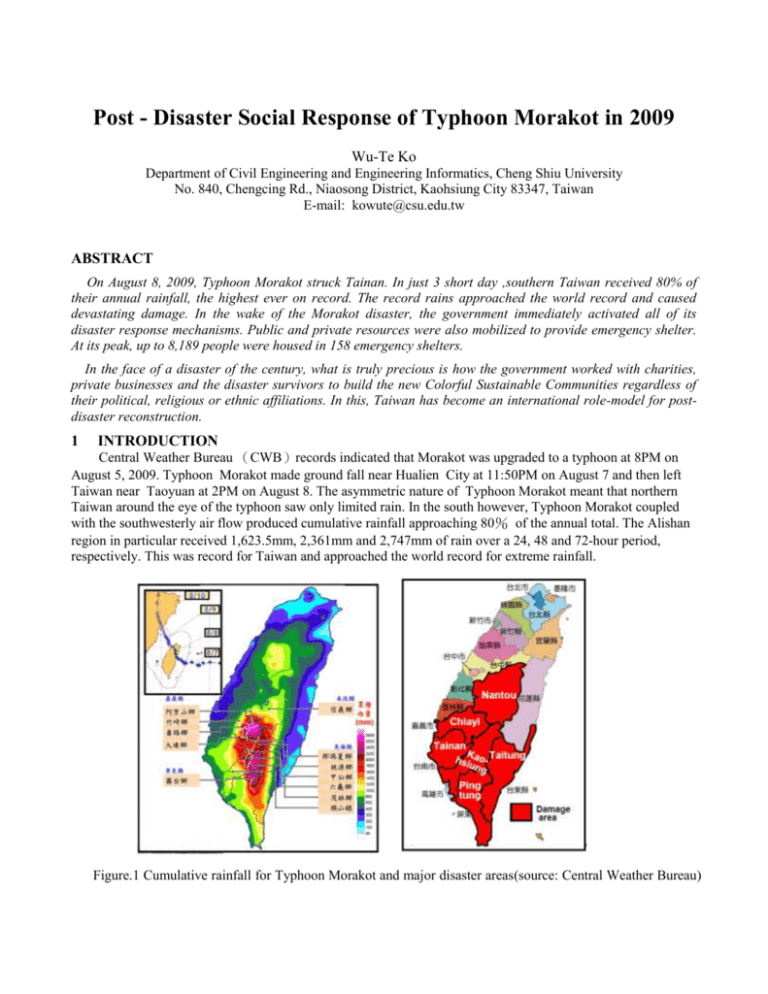
Post - Disaster Social Response of Typhoon Morakot in 2009 Wu-Te Ko Department of Civil Engineering and Engineering Informatics, Cheng Shiu University No. 840, Chengcing Rd., Niaosong District, Kaohsiung City 83347, Taiwan E-mail: kowute@csu.edu.tw ABSTRACT On August 8, 2009, Typhoon Morakot struck Tainan. In just 3 short day ,southern Taiwan received 80% of their annual rainfall, the highest ever on record. The record rains approached the world record and caused devastating damage. In the wake of the Morakot disaster, the government immediately activated all of its disaster response mechanisms. Public and private resources were also mobilized to provide emergency shelter. At its peak, up to 8,189 people were housed in 158 emergency shelters. In the face of a disaster of the century, what is truly precious is how the government worked with charities, private businesses and the disaster survivors to build the new Colorful Sustainable Communities regardless of their political, religious or ethnic affiliations. In this, Taiwan has become an international role-model for postdisaster reconstruction. 1 INTRODUCTION Central Weather Bureau (CWB)records indicated that Morakot was upgraded to a typhoon at 8PM on August 5, 2009. Typhoon Morakot made ground fall near Hualien City at 11:50PM on August 7 and then left Taiwan near Taoyuan at 2PM on August 8. The asymmetric nature of Typhoon Morakot meant that northern Taiwan around the eye of the typhoon saw only limited rain. In the south however, Typhoon Morakot coupled with the southwesterly air flow produced cumulative rainfall approaching 80% of the annual total. The Alishan region in particular received 1,623.5mm, 2,361mm and 2,747mm of rain over a 24, 48 and 72-hour period, respectively. This was record for Taiwan and approached the world record for extreme rainfall. Figure.1 Cumulative rainfall for Typhoon Morakot and major disaster areas(source: Central Weather Bureau) The final figures for Typhoon Morakot were 699 people dead or missing in Taiwan with 4 people seriously wounded and 1,766 houses rendered uninhabitable. The Executive Yuan designated 175 townships(townships, cities, districts)in 11 counties/cities as disaster areas. Household registrations from August 2009 indicated 2,875,000 households and 9,166,000 people in these areas. A total of 510,668 people in 146,739 households in Taiwan were affected by flooding, hilly land or river hazards. 491,477 people in 140,423 households experienced flooding to a height of than 50 ㎝. As for hilly land and river hazards, 19,191 people in 6,316 households were designated to be in the disaster area or as unsafe. Typhoon Morakot produced massive erosion on river banks flooding, landslides and debris flows in Taiwan·s mountainous regions. Some settlements in Kaohsiung County including Xiaolin Village in Jiaxian Township and Xinkai Village in Liugui Township that had been developed on the fan-shaped debris fields of old landslides were completely buried by massive landslides with no warning. In Kaohsiung County alone there 537 people dead or missing from Jiaxian, Namasia and Liugui in the mountains. Figure.2 Xiaolin Village before and after the disaster 2 DISASTER OF MAIN FACTOR According to the report on 「Couses of Disaster Xiaolin Village inJiaxian Township,Namasia Township and Taoyuan Township of Kaohsiung County」commissioned from the Chinese Institute of Civil and Hydraulic Engineering by the Public Construction Commission ,Executive Yuan, and the National Science and Technology Center for Disaster Reduction, multiple debris flow paths already existed in the region due to the nature of the local geology, road construction, land development and heavy rains from past typhoons. The banks of Laonong River and Cishan River had already collapsed in many parts as well as the local geology was quite unstable. When Typhoon Morakot struck, it triggered a massive landslide on the dip slope behind Xiaolin Village Extreme rainfall was also the main tactor for the landslides and debris flows in Namasia and Taoyuan. 3. RECONSTRUCTION PLAN On September 6, 2009, the 3rd committee meeting of the Reconstruction Council approved the 「Regional Reconstruction Master Plan prioritizing homeland conservation 」 proposed by the CEPD.The 「 Regional Reconstruction Master Plan」prioritizing homeland conservation was also completed to provide the relevant ministries and county(city)governments with overall guidance when formulating their Departmental Reconstruction Plan and Laval Reconstruction Plan and Local Reconstruction Plan. In accordance with the policies set out in the 「Regional Reconstruction Master Plan」,the relevant ministries proposed reconstruction approaches and actual implementation projects based on the three departments of 「 Infrastructure Reconstruction」,「Community Reconstruction」,「Industry Reconstruction」.Not only were all departmental reconstruction plans expected to be coordinated with each other, the homeland reconstruction plan must also take the needs of cultural and lifestyle reconstruction into account County(city)governments were also allowed to divide the disaster areas into several reconstruction units and develop a separate regional reconstruction plan for each area. Figure 3 Reconstruction Plan Framework With regards to the proposal for charities to construct permanent housing, the Reconstruction Council should liaise with local governments to select appropriate sites and charities as soon as possible. Once the projects are approved then construction may begin. For the medium to long-term, disaster survivors should in principle resettle in permanent housing. Due to differences in each site’s positioning, cultural characteristics and construction time, they vary in their industry development plans and employment training requirements as wekk. The industry plans for large-scale permanent housing sites. Da-Ai Community (Shanlin), Rinari Tribe and Baihe Community (Changzhi) are therefore provided here as examples: To look after the livelihoods for survivors at Da-Ai Community and Xiaolin Village, the government has coordinated with the Yonglin Foundation of the Hong Hai Group to set up a 62ha「Yonglin Orgnic Agriculture District」 to provide residents with employment opportunities. The Foundation Plans to invest NT$500 Million over 6 years and has so far carried out NT$90Million in construction so far. The overall plan consists of four phases: Build, Operate, Profit and Transfer. The aim is to provide disaster survivors with employment and development, with「Life, Production, Ecology」as the three key industry themes. These are combined with installation art, weekend farms and sale of Figure 4 Yonglin Organic Agriculture District organic produce to provide a varied tourism experience. 4. ACCOMPLISHMENTS OF PERMANENT HOUSING CONSTRUCTION After Typhoon Morakot, The construction of permanent housing saw the relevant central government ministries, 7 county(city)governments as well as the 6 NGOs responsible for actual construction build a close working relationship. Through continuous communication and coordination, One year after Typhoon Morakot, Yuemei Phase 1 in Kaohsiung City, the Mango Vapor Heat Plant at Yujin in Tainan City, Changzhi Phase 1 in Pingtung County, Luzijiao Phase 1 in Chiayi County and Taitung County (2sites) were completed. At these 6 sites, permanent housing for 1,100 households were built. Now, the 7 county(city) governments have approved 3,439 for permanent housing.41locatiom, 3,183 households will be provided(93% of permanent housing completed). Figure 5 Shanlin Da Ai Tribe permanent housing Figure 6 Rinari Tribe permanent housing 5. CONCLUSIONS Community reconstruction in particular was the most difficult and most challenging part of reconstruction. Over the past year or so, the combined efforts of the central governments, local governments and NGOs have made the process of constructing permanent housing a relatively smooth one. The public-private partnership with the government providing the land and NGOs pledging construction of permanent housing as well as allowing survivors to inherit but not sell/lease receiving housing is completely unprecedented and an experience well worth sharing with the international community. REFERENCES J.S. Lin and J.C Chern (2011), Rebuilding a Sustainable Homeland with Innovation and United Efforts, Morakot Post-Disaster Reconstruction Council, Executive Yuan.
